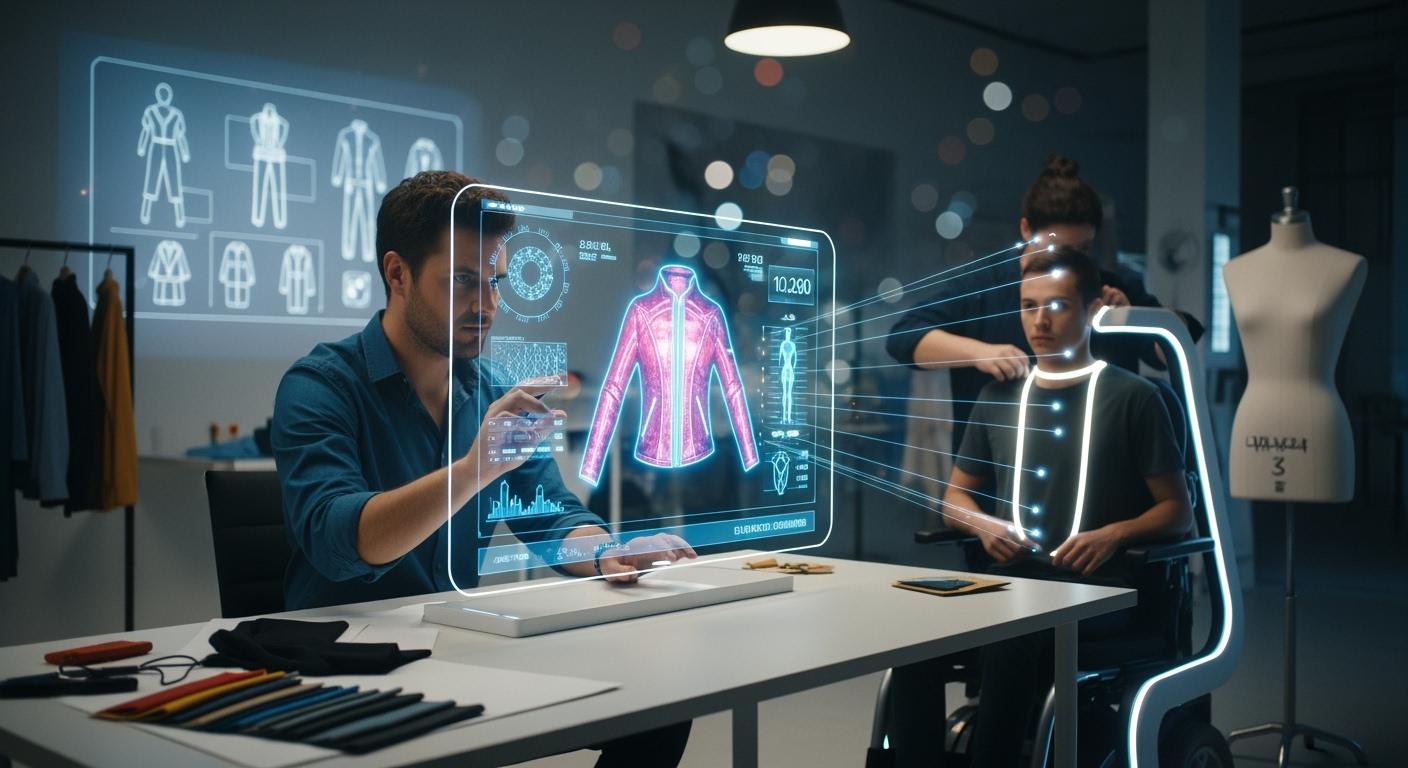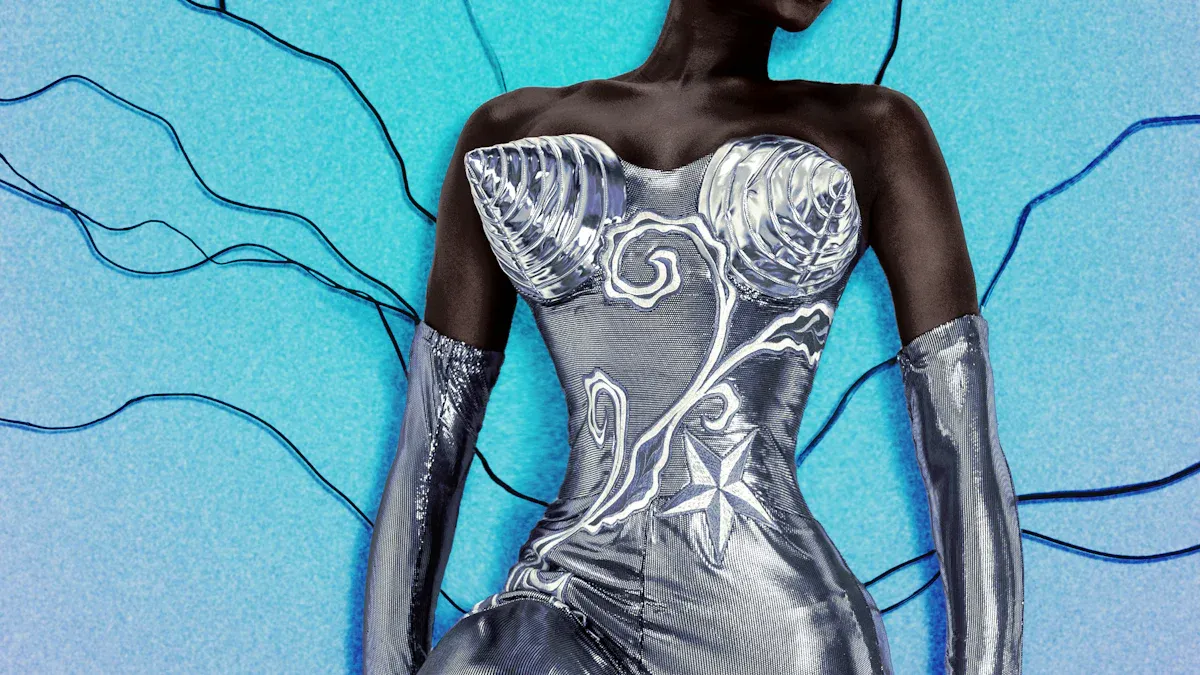
Artificial intelligence (AI) is the driving force behind a revolution in adaptive fashion. This technology creates intelligent styling solutions. It prioritizes both function and personal expression. Fashion AI moves beyond generic sizes to deliver true personalization. The growth of inclusive fashion is clear, with the adaptive clothing market expanding globally.
| Region | Market Size (2024) | Projected CAGR (through 2033) |
|---|---|---|
| Europe | USD 1.5 billion | 7.5% |
| Asia Pacific | USD 1.1 billion | Highest among all regions |
Fashion AI helps the design process, making adaptive fashion better. This use of AI creates more inclusive clothing for people with disabilities.
AI-Powered Personalization

Personalization is at the heart of modern adaptive fashion. AI transforms how designers approach this challenge. It moves the industry away from one-size-fits-all solutions. Instead, fashion AI creates clothing that honors unique body types and abilities. This technology delivers a new level of customization.
From 3D Scans to Perfect Fit
A perfect fit is the foundation of great clothing. Traditional tailoring often involves errors and multiple fittings. AI-driven 3D body scanning technology offers a better solution. It captures hundreds of precise body measurements in seconds. This process creates a detailed digital model of a person's body. AI algorithms then analyze this data to generate patterns for customized clothing. This method achieves incredible accuracy, with measurement differences of less than 3 mm compared to manual tailoring.
The fashion industry recognizes this potential. A recent survey showed 73% of fashion executives are prioritizing generative AI for such solutions. This technology helps create better-fitting clothes for all body types and abilities.
Note: AI processes key data points from scans, including individual body measurements and user input, to build the perfect pattern. This eliminates the guesswork common in standard sizing.
The table below shows how AI-powered scanning improves upon older methods.
| Feature | AI-driven 3D Body Scanning | Traditional Tailoring Methods |
|---|---|---|
| Measurement Accuracy | Millimeter accuracy | Prone to human error |
| Measurement Time | Seconds for a full scan | Lengthy sessions and multiple appointments |
| Body Shape Accommodation | Accurately captures diverse body shapes | Struggles with unique body types and abilities |
| Need for Alterations | Minimized due to high precision | Often requires several alterations |
This level of precision helps create customized clothing that fits perfectly the first time. It is a major step forward for inclusive fashion.
Creating Truly Adaptive Styles
True personalization goes beyond just fit. It includes personal style and functional needs. Fashion AI helps combine these elements. AI algorithms can suggest styles that match a person's taste. The system also considers specific mobility or physical requirements. For example, an AI can recommend a fashionable jacket with magnetic closures for someone with limited hand dexterity.
Platforms are already using this technology.
- xlook is one company using AI-powered adaptive styling intelligence.
- It offers personalized fashion guidance for people with disabilities.
- The platform considers both functional needs and a user's authentic style.
However, training an AI for fashion design has challenges. An AI can develop biases if its training data is not diverse. It might fail to represent different body types and abilities accurately. The AI must also learn the difference between creative fashion and unrealistic "hallucinations," like floating buttons. Overcoming these issues is key to creating truly adaptive and beautiful clothing. This careful design process ensures the final adaptive clothing is both functional and stylish.
Designing for Assistive Tech
Many people with disabilities use assistive technology. This includes prosthetics, wheelchairs, and other mobility aids. AI plays a vital role in designing garments that work seamlessly with this tech. An AI can simulate how different fabrics will stretch, bend, and wear over time. This helps designers create clothing that does not bunch up or restrict mobility.
For example, AI can help create tailored garments for people who use wheelchairs. The design process can analyze pressure points and movement patterns. This leads to pants with higher back rises and shirts with extra room in the shoulders. This thoughtful design improves comfort and function without sacrificing fashion. AI helps ensure that adaptive fashion empowers individuals, integrating style with practical needs.
Smarter Functional Design

Beyond a perfect fit, adaptive fashion must deliver superior function. AI elevates the practical design of clothing. It helps create garments that are not only stylish but also durable, easy to use, and comfortable. This focus on functional improvements is a core part of the AI revolution in fashion. Fashion AI provides designers with powerful tools to solve long-standing challenges in adaptive apparel.
Simulating for Durability
Adaptive clothing often endures unique stresses. A wheelchair user's pants may wear out at the knees, or a shirt may stretch from repeated pulling. AI simulations help designers predict and prevent this wear and tear. This technology allows for the virtual testing of fabrics before a single garment is made. The AI runs complex models to see how materials will perform over time.
These advanced simulations give designers deep insights.
- Advanced Dynamic Simulation: AI evaluates how textiles drape, stretch, and move with the body. It uses real-time data to predict fabric behavior.
- Multi-scale Modeling: This technique examines fabric from the microscopic fiber level to the macroscopic garment level. It helps understand the core properties of the material.
- Reinforcement Learning (RL): An AI can dynamically adjust simulation rules based on feedback. This allows it to model a wide range of fabric behaviors under different conditions.
Using AI for durability testing offers major advantages over traditional methods. It provides more accurate predictions and deeper insights into how fabrics interact with a garment's design. This process helps create long-lasting fashion that meets the specific needs of the wearer.
Innovating Closures and Fastenings
Simple tasks like buttoning a shirt can be difficult for individuals with limited hand dexterity or arthritis. Innovative closures, such as magnetic snaps and one-handed zippers, offer greater independence. Fashion AI plays a key role in the design phase of these solutions.
Note: AI-powered custom design tools allow designers to create virtual previews of garments with new closure systems. This application focuses on the visualization and design aspect rather than the physical prototyping of the closure mechanisms themselves.
This technology helps designers visualize how a magnetic closure will look and integrate into a piece of fashion. A fashion AI can help ensure the placement is both functional and stylish. This speeds up the design process. It allows for rapid iteration before creating a physical sample. The AI helps perfect the look and feel of these important adaptive features.
Addressing Sensory Needs
For many individuals, especially those with autism or sensory processing disorders, clothing can be a source of discomfort. Rough seams, scratchy tags, and certain fabric textures can cause irritation. AI is a powerful ally in creating sensory-friendly fashion. It helps designers build garments that prioritize comfort from the ground up.
Specialized tools like the 'Adaptive Clothing Developer' guide this process. This AI assists designers in creating irritation-free adaptive clothing. It suggests materials like soft, breathable fabrics that feel good against the skin. For example, a brand developing a line for children with autism can use this AI to select materials that minimize irritation. The fashion AI helps design garments with flat seams and no tags to provide maximum comfort and flexibility. This thoughtful approach ensures the final product is a source of comfort, not distress.
The Future of Adaptive Clothing
The future of adaptive clothing points toward a deeper fusion of fashion and technology. AI is at the forefront of this evolution. It promises garments that are not just accommodating but truly intelligent. This progress in fashion reflects a broader cultural shift towards inclusivity and diversity. The next wave of design will redefine what clothing can do for the wearer.
Smart Textiles and AI
Smart textiles are fabrics with integrated technology. AI is making these materials more powerful. This combination creates a new frontier for fashion. The fashion AI can change a garment's properties based on weather or user activity. This technology is leading to exciting innovations.
- Intelligent Fabrics: Researchers are creating flexible textiles with built-in sensors. These fabrics can sense and respond to movement.
- Energy Harvesting: New systems generate power from body heat and motion. This allows the clothing to operate without external power.
- Personalized Functions: A fashion AI analyzes user data to tailor a garment's functions. For example, Xenoma’s e-Skin offers fitness advice based on motion data.
AI also improves health monitoring through fashion. Smart textiles with flexible biosensors can track heart rate and posture. The AI processes this data, using advanced algorithms to improve accuracy by up to 25%. This intelligent design transforms a simple garment into a personal health assistant.
Voice-Activated Features
Voice control is another major advancement in fashion. Scientists developed A-Textile, a voice-controlled smart fabric. This material turns clothing into an AI assistant. The fabric detects speech patterns using natural electrostatic charges. It achieves 97.5% voice recognition accuracy. This allows the fabric to "listen" without a traditional microphone.
This capability opens up new possibilities. A person can use their clothing to control smart home devices or get directions. The AI can also provide styling help. A user could ask their shirt for outfit recommendations. This fashion AI could even enable virtual try-ons powered by augmented reality through simple voice commands. This hands-free interaction offers greater independence.
AI for Inclusive Maternity Wear
Maternity wear is an area where adaptive design is essential. AI offers new ways to create comfortable and supportive clothing for expectant mothers. A fashion AI can optimize the design of adjustable features like support bands and waistbands. This ensures a better fit throughout pregnancy.
The future of this fashion includes built-in sensors.
- These sensors allow the clothing to adjust automatically to a changing body shape.
- This smart maternity wear can also monitor vital signs.
- It can even track fetal movements for added peace of mind.
This adaptive approach enhances both comfort and function. The use of AI in this area of inclusive fashion helps create a better experience for mothers.
AI elevates adaptive clothing from a medical necessity to a world of personal expression. This technology makes garments that are both fashionable and accessible. It empowers individuals with disabilities, offering greater independence and confidence. The fusion of AI and design is creating a future where everyone can express themselves through their clothing choices. Future trends will likely include:
- AI platforms allowing customers to personalize designs.
- Smart textiles that adapt to different body shapes.
- Collaborative processes where users help create their own clothing.
FAQ
What is the main role of AI in adaptive clothing?
AI helps designers create personalized and functional clothing. It analyzes data to improve fit, suggest styles, and test fabric durability. This technology makes fashion more inclusive for people with disabilities, enhancing both comfort and personal expression.
How does AI help clothing fit better?
AI uses 3D body scans to capture hundreds of precise measurements. Algorithms then create custom patterns from this data. This process ensures a perfect fit for diverse body types and abilities, which minimizes the need for alterations.
Can AI design adaptive clothing by itself?
No, AI is a powerful tool that assists human designers. It can suggest ideas and solve complex problems. Designers must guide the AI to prevent errors and ensure the final clothing is both practical and stylish.
What is a smart textile in adaptive fashion?
A smart textile is a fabric with built-in technology like sensors. These fabrics can monitor health or respond to the environment. AI processes data from these sensors, turning a simple garment into an interactive and functional assistant.
See Also
Revolutionary AI in Fashion: Sustainable Solutions for a Greener Planet
Future of Textiles: AI-Powered Predictive Maintenance by 2025
Optimizing Fashion Returns: Immediate Streamlining with Intelligent AI Solutions
Fashion Retail's Future: Dynamic Safety Stock AI by 2025
Transforming Apparel: Strategic Paths from Manufacturing to Branding Success